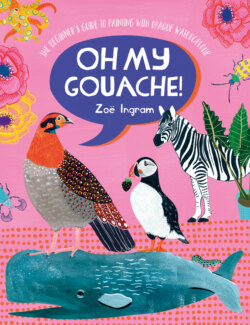Читать книгу Oh My Gouache! - Zoë Ingram - Страница 8
На сайте Литреса книга снята с продажи.
ОглавлениеThe Paint
Gouache:
[goo-ash, gwash or goo-uhsh] noun
A method of painting using opaque pigments ground in water and thickened with a glue-like substance.
Opaque watercolour of the type used in gouache painting.
A picture painted using the gouache method.
The pronunciation of gouache varies from person to person and can sound like 'gooash', 'gwash' or 'goo-uhsh'. The term originated in France in the eighteenth century, but the earliest gouache paints are known to have been made in ancient Greece and Egypt. These early gouache paints were very similar to tempera paints, which are usually semi-opaque compared to gouache as we know it now.
There are some very well-known painters who used gouache in their work, one of whom is the French artist, Henri Matisse. He used gouache to achieve the flat, bold colour he’s famous for in his paper cut-outs. Another fantastic artist who historically used gouache is Paul Klee. Both of these artists are favourites of mine and I’d definitely recommend looking at their works for inspiration.
How it works
As the definition states, gouache is water-based paint that is essentially made up of pigment, binding agent and water, producing an opaque, flat, matt finish. The flat opaqueness of the paint gives a solid graphic feel and has no reflection or sheen, which makes photographing or scanning your work much easier. This also means that the paper doesn’t show through, unless you dilute the paint so much that it becomes like watercolour paint. Gouache paint dries fairly quickly, too, which I find to be a big bonus. Light colours usually dry slightly darker than they look when wet, and dark colours can look slightly lighter when dry. This could be due to the opaqueness of the paint absorbing light rather than allowing light to pass through to the paper underneath as it does with watercolour paint.
YOU GET WHAT YOU PAY FOR
Paint price varies depending on the colour and the brand. Be wary of very cheap paint, as it’s likely to have less pigment and more binder so could prove to be a false economy.
Choosing your paint
Primary colours are usually the most affordable and sometimes come in beginner sets, which I’d recommend starting with as a bare minimum. Add white and you have all you really need to get going. I’ll show you how to mix many colours from these four paints! You can add more non-essential colours to your toolkit as you need them. I use certain colours straight from the tube because they’re so unique and hard to replicate by mixing.
In addition to traditional gouache, there is a particular kind of hybrid gouache paint that is gouache mixed with an acrylic element: acrylic gouache. I use both types of gouache in my work. Acrylic paint is polymer based, which means that when it dries, it can’t be reconstituted or blended with water. I like the permanence of acrylic gouache, and I’ll be using it in the elements of the projects in this book where I wanted to keep the layers distinct.
Pure gouache, however, can be reconstituted once it has dried out on the palette and, to an extent, on the paper. All you need to do is add water to the dried-up paint and – voila! – you can use it again. For this very reason, take care when using it wet on already dry paint because the layer underneath can be lifted and muddied with any new addition over the top. This doesn’t apply if you’re painting directly on top of acrylic gouache.
Gouache is, in my opinion, the easiest of paint mediums to use. It’s very forgiving and fun to use. It’s also versatile. Gouache paint can mimic watercolour or can give the opacity of oil paint if used with less water. You can use it to paint large, smooth, flat blocks of background colour and the finest lines and details.
